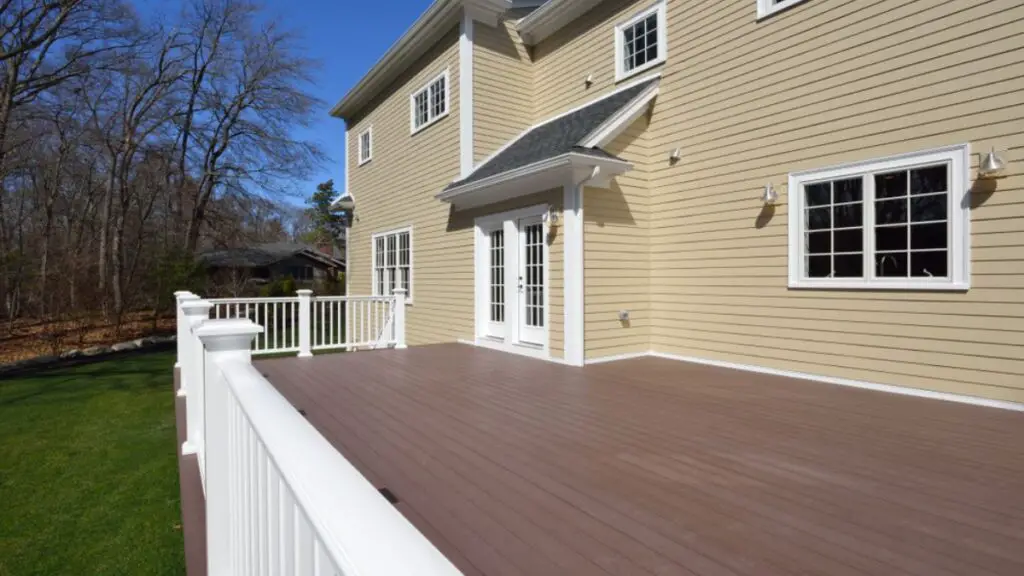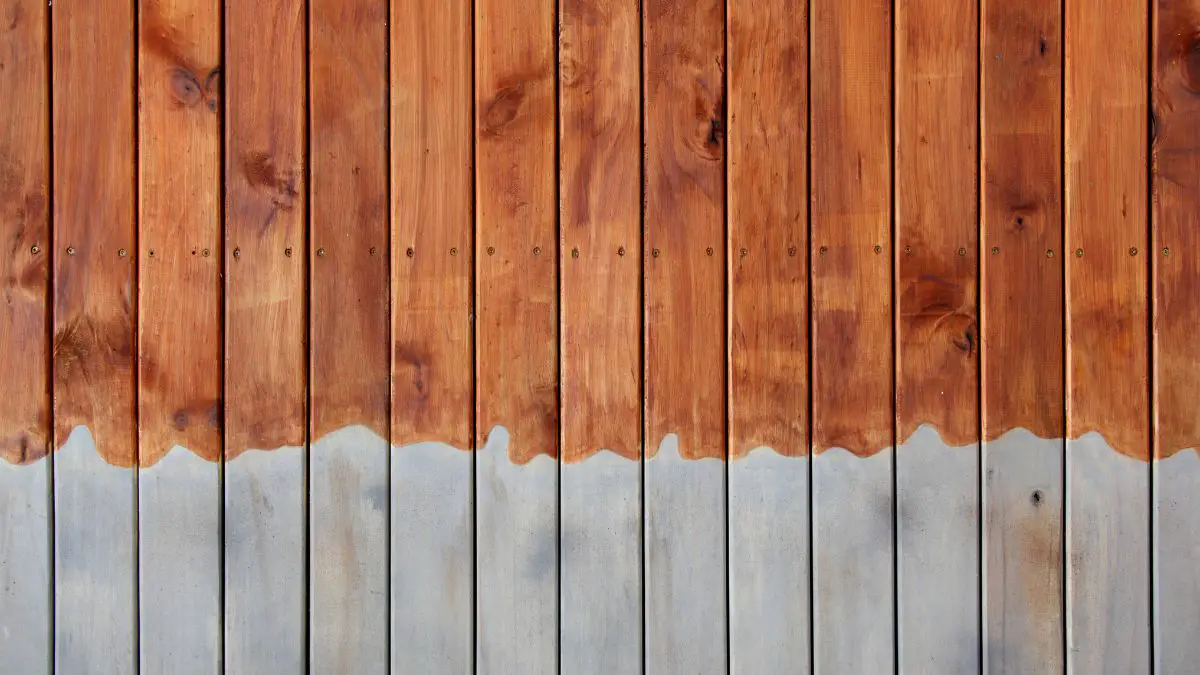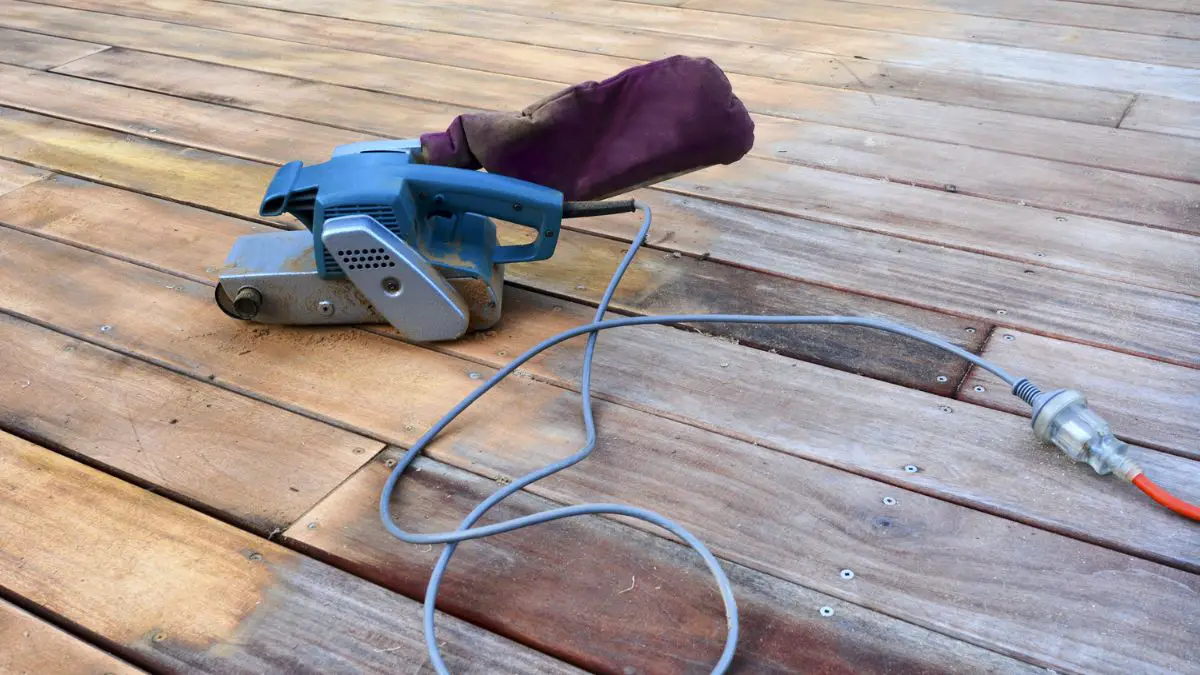Cleaning Trex decking involves regular sweeping, washing with a mild, soapy water solution, and rinsing with a garden hose. For stubborn stains, use a specialized deck cleaner and a soft bristle brush to scrub the area gently.
Key Takeaways: How to Clean Trex Decking
Here are some tips for general Trex deck maintenance, removing stains, and dealing with mold and mildew:
General Maintenance
For general maintenance, cleaning your Trex deck on a semiannual basis or as needed is recommended. The rain alone should be enough to wipe away most of the dirt and debris that will gather on it. However, you can also:
- Remove debris from your deck with a hose or a broom.
- For grime buildup from dust and dirt in the grains of the boards, use a deck scrub brush (soft or stiff bristles) and mild dish soap to get into the grooves and remove the grime.
- After scrubbing, rinse your deck thoroughly.
Removing Stains
Trex recommends cleaning the deck within 7 days for oil and grease stains for best results.
- Spray down the surface with water and then use soapy water to rinse away what’s left of the oil and grease.
- Use a stiff bristle brush and a product like “Penofin Knotwood, Penetrating Oil Stain for Synthetic Decking” for stubborn oil stains.
- For plaster stains, you might need some acidic cleaner. Vinegar is suggested as a good starting point, especially for gypsum and calcium-based plasters.
- You can use a commercial Trex deck cleaner like Simple Green Oxy Solve Deck and Fence Pressure Washer Cleaner, available from Amazon.
Mold and Mildew
To remove mold and mildew from your Trex deck:
- Mix vinegar and water into a bucket and pour the solution directly on the mold.
- After the solution is poured, sprinkle some baking soda on the area.
- Let this compound sit and soak for 20 minutes, and then use your gentle bristle brush to scrub the area and remove any leftover mold and mildew.
- Rinse thoroughly after scrubbing.
Never mix ammonia-based ingredients with bleach, which can create toxic chloramine gas and cause respiratory irritation.
Avoid using acetone or any solvent cleaning product on your Trex deck board, as these chemicals can damage the composite Trex boards and negatively impact the deck’s appearance.

Understanding Trex Decking
Before we dive into the cleaning process, let’s take a moment to understand what Trex decking is and why it’s such a popular choice for homeowners.
Trex decking is a composite material designed to mimic the look and feel of natural wood but with a host of added benefits. It’s made from a blend of recycled wood fibers and plastic, creating a product that’s incredibly durable and resistant to the elements.
One of the main benefits of Trex decking is its longevity. Unlike traditional wooden decks, Trex decks are designed to last for decades with minimal maintenance. They’re resistant to rot, warping, and insect damage, making them a great choice for any climate. They come in various colors and styles to create the perfect look for your outdoor space.
Another key advantage of Trex decking is its eco-friendliness. The materials used in its construction are 95% recycled, making it an excellent choice for environmentally conscious homeowners.
But, like any outdoor surface, Trex decking isn’t completely maintenance-free. Over time, dirt, grime, and stains can build up on the surface of your deck. Mold and mildew can also be a problem, especially in damp climates.
Basic Cleaning of Your Trex Deck
Now that you understand what Trex decking is and why it’s a fantastic choice for your outdoor space, let’s delve into cleaning your deck.
Cleaning your Trex deck is a task you should undertake regularly. Why, you ask? Well, regular cleaning not only keeps your deck looking its best, but it also helps to extend its lifespan.
Surface dirt, grime, and other debris can build up over time, leading to unsightly stains and potential damage. By cleaning your deck regularly, you can prevent these issues and keep your deck looking as good as new.
Tools and Materials You’ll Need for Basic Cleaning
- A soft bristle brush
- Mild soap (such as liquid dish soap)
- Warm water
- A bucket
- A garden hose
Now, let’s get down to the nitty-gritty of basic Trex deck cleaning. Follow these simple steps to keep your deck looking its best:
- Remove any loose debris. Start sweeping your deck with a soft bristle broom to remove loose dirt and debris. Pay particular attention to the areas between the individual deck boards and where the deck meets the house. These areas can often harbor dirt and debris.
- Prepare your deck cleaning solution. Mix warm, clean water in a bucket with a squirt of mild soap. You don’t need much soap – a little goes a long way.
- Scrub the deck. Dip your soft brush into the cleaning solution and start scrubbing. Work in sections, starting at one end of the deck and working your way across. Scrub all deck areas, including the boards, railings, and stairs.
- Rinse thoroughly. Once you’ve scrubbed the entire deck, rinse it thoroughly with a garden hose. Remove all soap residue, as it can leave a film on the deck if left to dry.
- Let the deck dry. After rinsing, let your deck dry completely. This is especially important if you plan to apply a deck sealer or stain.

Dealing with Stains on Your Trex Deck
Even with regular cleaning, stains can still occur on your Trex deck. From drinks and food spills to bird droppings and tree sap, there are many potential sources of stains.
Common types of stains on Trex decks include:
- Food and drink stains: The most common type of stain you’ll encounter, especially if you frequently dine or entertain on your deck.
- Grease stains: If you have a grill on your deck, you may encounter grease stains. Removing these can be tricky, but it’s possible.
- Mold and mildew stains: Mold and mildew can be expected in damp climates. These stains can be green, black, or brown, often appearing in shady deck areas.
- Tannin stains: These are caused by natural tannins in the wood fibers used to make Trex decking. They often appear as reddish-brown streaks.
- Rust stains: Occur from metal patio furniture or other metal objects left on the deck.
Now, let’s talk about how to remove these different types of stains. Here are some general cleaning steps to follow:
- Identify the type of stain. The first step in removing a stain is identifying what caused it. This will help you determine the best cleaning method.
- Prepare your cleaning solution. A solution of warm water and mild soap will do the trick for most stains. You may need a specialized cleaner for tougher stains like grease or rust. Always follow the manufacturer’s instructions when using these products.
- Apply the cleaning solution. Apply the cleaning solution to the stain and let it sit for a few minutes. This will help loosen the stain and make it easier to remove.
- Scrub the stain. Using a soft-bristled brush, scrub the stain in a circular motion. Be sure to scrub gently to avoid damaging the deck surface.
- Rinse and dry. Rinse the area thoroughly with a garden hose, then let it dry completely.
When dealing with stains, there are a few precautions to keep in mind:
- Avoid using harsh chemicals. Harsh chemical cleaning can damage the surface of your Trex deck. Always opt for mild cleaners and follow the manufacturer’s instructions.
- Test any new cleaners in an inconspicuous area first. Before applying a new composite deck cleaner to a visible area of your deck, test it in an inconspicuous area to be sure it won’t discolor the decking.
- Never use a pressure washer. Pressure washers can damage Trex decking. Always stick to a garden hose for rinsing.
Removing Mold and Mildew from Your Trex Deck
Mold and mildew can be common for many outdoor surfaces, including your Trex deck. These pesky fungi thrive in damp, shaded areas and can cause unsightly green or black stains.
Mold and mildew occur on Trex decks due to moisture and lack of sunlight. If trees or other structures shade your deck or you live in a damp climate, you might be more likely to see mold and mildew growth. These conditions provide the perfect environment for these fungi to thrive.
Here’s a step-by-step guide to removing mold and mildew from your Trex deck:
- Prepare your cleaning solution. For mold and mildew, you’ll need a specialized cleaner. Look for a product that’s designed for use on composite decking and is safe for the environment.
- Apply the cleaner. Spray or pour the cleaner onto the affected areas of your deck. Follow the manufacturer’s instructions for how long to leave the cleaner on the surface.
- Scrub the deck. Using a soft bristle brush, scrub the mold and mildew stains. Remember to scrub gently to avoid damaging the deck surface.
- Rinse thoroughly. Rinse the deck thoroughly with a garden hose to remove the cleaner and any loosened mold or mildew.
- Let the deck dry. Allow the deck to dry completely. This is especially important, as leaving moisture on the deck can lead to more mold and mildew growth.
Now that your deck is clean, let’s discuss preventing mold and mildew growth. Here are some tips:
- Improve sunlight exposure. If possible, trim overhanging trees or other structures, shading your deck. More sunlight can help keep your deck dry and prevent mold and mildew growth.
- Clean your deck regularly. Regular cleaning can help prevent the buildup of dirt and moisture that can lead to mold and mildew growth.
- Ensure proper ventilation. If your deck is close to the ground, make sure there’s adequate ventilation to help keep the underside of the deck dry.
- Consider a mold-resistant sealer. Sealers are available to provide an extra layer of protection against mold and mildew.

Advanced Cleaning Techniques for Your Trex Deck
Sometimes, basic cleaning might not be enough to get your Trex deck looking its best. That’s when it’s time to bring out the big guns and use some advanced cleaning techniques. These methods tackle stubborn stains and deep-seated dirt that regular cleaning can’t handle.
You might need to use advanced cleaning techniques when dealing with persistent or tough stains that don’t respond to basic cleaning. These could include severe mold and mildew stains, ground-in dirt, or stubborn grease stains from your summer barbecues.
For advanced cleaning, you’ll need some additional tools and materials:
- A specialized deck cleaner designed for tough stains
- A soft bristle brush
- Warm water
- A bucket
- A garden hose
- Protective gloves and eyewear
Now, let’s dive into the step-by-step guide to advanced cleaning:
- Prepare your cleaning solution. Depending on the type of stain you’re dealing with, you might need a specialized deck cleaner. Always follow the manufacturer’s instructions when preparing and using these cleaners.
- Apply the cleaner. Apply the cleaner to the stained areas of your deck. Some cleaners need to sit on the surface for a while to work effectively, so follow the instructions on the label.
- Scrub the deck. Use your soft bristle scrub brush to scrub the deck. You might need to apply more pressure for tough stains, but always be careful not to damage the deck surface.
- Rinse thoroughly. Rinse the deck thoroughly with your garden hose to remove the cleaner and any loosened dirt or stains.
- Let the deck dry. Allow the deck to dry completely before using it again. This is especially important if you plan to apply a sealer or protectant afterward.
Related Reading: Can You Paint or Stain Composite Decks?
Frequently Asked Questions About How To Clean Trex Deck
How do I remove candle wax from a Trex deck?
Candle wax can be tricky to remove, but it’s doable. Start by placing an ice pack on the wax to harden it. Gently scrape off as much as possible with a plastic scraper, careful not to scratch the deck surface. Clean the area with a mild soap and warm water solution.
What kind of soap should I use for cleaning my Trex deck?
Mild dish soap is usually the best choice for cleaning your Trex deck. It’s gentle enough not to damage the deck surface but effective enough to remove dirt and light stains. Avoid using harsh detergents or bleach, as these can cause discoloration.
We have hard water, and the deck looks dull. Any advice?
Hard water can leave mineral deposits on your deck, causing it to look dull or discolored. To remedy this, use a deck cleaner to remove mineral deposits. You can also consider installing a water softener system to reduce the hardness of your water.
How often should I refinish my deck?
The frequency of refinishing your deck depends on several factors, including the type of finish used, the deck’s exposure to the elements, and the amount of foot traffic it receives. Generally, a deck should be refinished every 2-3 years to maintain its appearance and protect the wood.
Can I refinish my deck myself or should I hire a professional?
Refinishing a deck is a task that many homeowners can do themselves with the right tools and time. The process involves cleaning the deck, repairing damaged areas, sanding, and applying the new finish.







